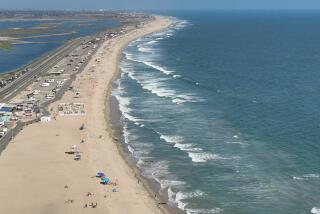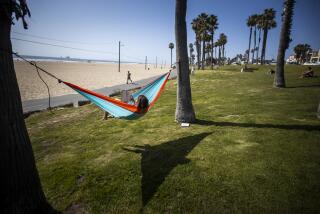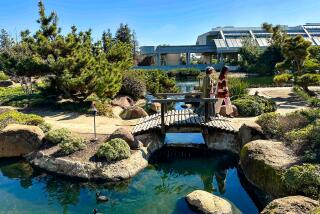Lake Michigan Dunes: Wonders From the Ice Age
- Share via
MUSKEGON, Mich. — From the air, they don’t seem that impressive--long, tree-covered sandy clumps hugging the beach at the edge of flat, Midwestern terrain.
Up close, well, that’s a different story. In total, they make up the world’s largest accumulation of sand mountains along a body of fresh water.
They are the Lake Michigan dunes, a stretch of sand peaks that starts at the edge of Chicago’s metropolitan sprawl and continues for more than 200 miles up the eastern shore of Lake Michigan. The lake’s western shore is mostly flat beach, but the eastern side is flanked by sand mountains that were deposited by Ice Age glaciers.
An Hour From Chicago
The first dunes are about an hour’s drive--or a commuter train ride--from downtown Chicago, on the northern shore of neighboring Indiana. These are in the West Beach area of the Indiana Dunes National Lakeshore. Within a 3 1/2-hour stretch, Chicago to Holland, Mich., lies a wide variety of beach and sand dunes that can provide days of entertainment in any season.
Despite the dunes’ nearness to the Chicago megalopolis (now about 6 million people), this spectacular natural resource was, for a long period, of only limited interest to Windy City inhabitants. North to Wisconsin was the preferred weekend and vacation direction. In the 1950s, Illinois Sen. Paul Douglas, a Chicago native, was chided as the “third senator from Indiana” for his efforts to prevent the leveling of a prime section of dunes to build another steel mill.
The situation today is very different, as the crowds at the Paul H. Douglas Ecological and Recreational Unit at West Beach attest to. This attractive area has been designed by the National Park Service to show users the beauty as well as the fragility of the dunes’ ecosystem. A fenced “Dune Succession Trail” takes hikers through fore dunes, back dunes and barrier dunes, passing dune fauna (which can vary considerably between neighboring dunes) and overlooking Lake Michigan.
New Facilities
Handsome and large new sandstone-look bathhouses provide clean facilities for warm-weather visitors to West Beach, one of the most inspired examples of how natural areas can be meshed with human intrusion. West Beach is close to pristine, and is only the beginning of a long stretch of unspoiled dune areas.
Federal legislation establishing the national lake shore was passed, ironically, within days of Sen. Douglas’ reelection defeat in 1966. A plaque at West Beach notes the senator’s reflections: “When I was young,” Douglas once remarked, “I hoped to save the world. In my middle years I would have been content to save my country. Now I just want to save the dunes.”
The national lake shore stretches 26 miles toward the Michigan border. Besides a few attractive dune communities such as Dune Acres and Beverly Shores, it is interrupted by Indiana Dunes State Park, the granddaddy of the dune recreation areas.
For generations, “going to the dunes” meant going to this three-mile lake-front park, which includes the 192-foot Mt. Tom, the 176-foot Mt. Jackson and the 184-foot Mt. Holden dunes. The old dance pavilion at the park is reminiscent of the big band era, when couples would drive out for Saturday night waterfront dances.
Served by Train Line
Visitors can reach the Indiana dunes via the South Shore electric railroad. Known as “the nation’s last inter-urban,” the South Shore shuttles commuters and dune visitors alike between Chicago and northern Indiana. For $5.50 you can travel from Chicago’s bustling downtown Loop to the South Shore’s new Dune Park Station, a mile walk from the state park.
Gerald Franke, South Shore manager, says that weekend visitors help keep the South Shore line running. “We can get as many as 4,500 day trippers on a summer weekend,” Franke says. “Most folks enjoy the quiet walk from the station into the park, a nice change from waiting in a line of cars for a parking space.”
Mt. Baldy, just west of Michigan City, Ind. (terminus of the South Shore), brings up the eastern edge of the national seashore. It’s 129 feet high, and is a favorite for dune climbers.
After Michigan City--a greening old industrial town whose lake front boasts one of the few municipal parks anywhere that includes a sand dune-studded beach--comes the Michigan state line and a string of longtime resort communities.
Starting at New Buffalo, they include cottages, private homes and a few inns on cliffs or dunes above the lake. The first of Michigan’s delightful sand dune state parks is Warren Dunes, about 15 miles into Michigan on the lake road (or inland on Interstate 94).
A 150-Foot ‘Jump’
Warren Dunes State Park is in a pretty crescent of beach just north of Harbert, Mich., with three bathhouse and concession pavilions serving weekend crowds in summer and fall. The main dune at Warren, about 150 feet high, provides a wonderful staging area any time of year for those who like the feel of running down a dune, that satisfying sensation of being fluidly propeled downhill by gravity, as if on a fail-safe parachute jump.
Two hundred yards from the base await Lake Michigan’s whitecapped waters. In hot weather they provide comfortable freshwater swimming, lacking the strong currents of the ocean (although dangerous riptides can occur on the lake in storm conditions), as well as the buoyancy of salt water. The rest of the year, due to prevailing westerly winds, they provide a picture of chilly blue infinity fringed in white.
The lake road north (U.S. 31) past Benton Harbor-St. Joseph passes through thickly forested areas that in some places are still quite undeveloped. Unpaved tracks branch off to the lake, often ending on wooded bluffs above the shore. As you look down from these promontories you can see a major reason for lack of development on such prime shore property: Lake Michigan is rising and the beaches are disappearing.
A Dubious Investment
For the past couple of years, the water level has washed out innumerable docks and stairways to beach property. The causes are apparently both natural (cyclic changes in water levels) and man-made (diversion of water into the lake to aid shipping), but the result is that shore property is becoming a dubious investment.
Many dune dwellers are being forced inland. A retired professor and his wife, whose dream dune house is on the market, sums up the problem: “First the stairs washed out so we couldn’t get to the beach. Then more erosion. The only question in my mind is which will last longer, the house or us?”
After Van Buren Dunes (35 miles past Warren Dunes) and its sparkling beaches, the next dune park is Saugatuck Dunes. Just a few miles north of the lively all-year resort town of Saugatuck (with clapboard-and-shingle architecture and a picturesque boat harbor), this attractive park is used mostly by residents, and is not on all maps. Unlike other parks coming up the lake shore, this one has a tiny parking lot and no concession stands or other signs of tourist activity.
Winding trails of mostly soft sand take you through dense woods over and around a series of gentle dunes to the park’s beach front. In winter these trails become a network of scenic cross-country ski paths.
Bold Array of Colors
In spring, wildflowers dot the forest floor, and in fall the oaks and maples provide a bold array of colors that mesh with the blue Michigan sky, the off-white dunes and the evergreens. In summer it is a dynamic swimming hole, its waters providing relief from the hot Midwestern sun.
Sitting on a dune, leaning against a birch tree 10 stories above the beach, feeling the wind and watching the water, can be a full afternoon’s pastime. The shore is a virtually unbroken line of green and beige dune, bowing out slightly to the north and south.
To the south, beyond this five-mile crescent, is Saugatuck Harbor and Singapore, a ghost town founded near the mouth of the harbor but now buried under dune sands.
Past the cusp--due north--is the entrance to Lake Macatawa, marked by a profusion of sailboats most of the year. The five-mile-long muddy lake ends in Holland, a 19th-Century Dutch settlement that retains considerable Old World flavor.
The dunes go way beyond Holland, past Sleeping Bear Dunes National Seashore (a popular camping are) for 150 miles. Closer in is the Gillette Nature Center near Muskegon (25 miles), which features a multi-image slide show interpretive program about the dunes.
Dunes abound in either direction, just as Sen. Douglas and other conservationists hoped they would continue to do in perpetuity. They are a rare, yet simple treasure. One dune aficionado observed: “They are only piles of sand, but how beautiful they are.”
For more information, contact Superintendent, Indiana Dunes National Lakeshore, 1100 N. Mineral Springs Road, Porter, Ind. 46304. For hotel information, contact Michigan Department of Commerce, Travel Bureau, Box 30226, Lansing, Mich. 48909, phone (800) 543-2937.
More to Read
Sign up for The Wild
We’ll help you find the best places to hike, bike and run, as well as the perfect silent spots for meditation and yoga.
You may occasionally receive promotional content from the Los Angeles Times.






